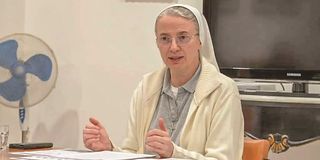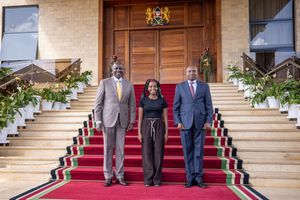The changing face of Catholic: Vatican's shift towards gender-inclusive leadership

Sister Simona Brambilla.
What you need to know:
- Catholic women have consistently expressed dissatisfaction with their perceived inferior status within an institution that exclusively grants the priesthood to men.
- Sister Simona, a distinguished figure in psychology, has held the esteemed position of superior general of the Consolata Missionaries while dedicating herself to missionary work
The absence of women in any capacity has characterised the Catholic Church from its inception. Pope Francis seeks to portray himself as a progressive leader, and his recent appointment of Sister Simona Brambilla has garnered significant attention, marking a noteworthy development.
Catholic women play a significant role in the church's endeavours within educational institutions and healthcare facilities, as well as in the transmission of faith to subsequent generations. However, they have consistently expressed dissatisfaction with their perceived inferior status within an institution that exclusively grants the priesthood to men.
This appointment marks the first time in the history of the Catholic Church that a woman has held this position. The current prefect of the Dicastery for Institutes of Consecrated Life and Societies of Apostolic Life is Sister Simona Brambilla, an Italian nun. Sister Simona, an Italian nun, has taken on the role of the new prefect. Before this, no woman had held this post.
Sister Simona, a distinguished figure in the field of psychology, has held the esteemed position of superior general of the Consolata Missionaries while dedicating herself to missionary work. She is a dedicated professional in the nursing field.
In 1988, she became a member of the church and received a missionary assignment to Mozambique. Additionally, the nun served as the first general counsel for the order. Because of this experience, she was able to not only get a doctorate in psychology from the Gregorian Institute of Psychology in 2008, where she also taught but also write a thesis on the topic of evangelisation and inculturation in Africa.
The appointment comes as part of Pope Francis’ push to give women more leadership roles in “governing the church”. Purpose is an important step. It was difficult to imagine a woman leading the Vatican Dicastery before 2022. This changed when Pope Francis introduced ‘Predicate Evangelium’. This document reformed the rule of the Roman Curia. The Vatican occasionally refers to offices as “dicasteries”.
A dicastery serves as a central administrative office tasked with executing governing responsibilities. Previously, the term referred to types of Vatican offices in a broader context.
Sister Simona, 59, is a Consolata missionary and a member of the religious order. Since last year, the departments of command have ranked second. This historic decision is an important step towards women's empowerment. A woman can or should hold this position for a long time. People believe this to be true.
Not long ago, an important Vatican summit of world Catholic leaders emphasised the importance of giving women more important leadership roles. Cardinals, bishops, and citizens from 100 countries attended the meeting. They discussed the issue of women's empowerment within the church. There were 258 votes in favour and 97 votes against the vote on women deacons.
Pope Francis also gave women the right to vote for the first time. This reflects his desire to give women more extraordinary decision-making power in the affairs of the Catholic Church, and shows participating in decision-making at the highest levels to reflect gender equality within the church as an important step. He created two Vatican commissions to consider the ‘ordination’ of women as deacons.
Francis has maintained the prohibition on female priests and diminished expectations regarding the ordination of women as deacons. During his papacy, there has been a significant rise in the proportion of women employed in the Vatican, including in leadership roles, increasing from 19.3 per cent in 2013 to 23.4 per cent currently, as reported by Vatican News.
Among the women in leadership roles is Sister Raffaella Petrini, the inaugural female secretary general of the Vatican City State, overseeing the territory's healthcare system, police force, and primary source of revenue, the Vatican Museums, which are directed by a laywoman, Barbara Jatta.
Another nun, Sister Alessandra Smerilli, holds the position of second-in-command in the Vatican development office, while multiple women have been appointed to undersecretary roles, including a French nun, Sister Nathalie Becquart, in the office of the synod of bishops.
The writer is a veteran journalist and freelance writer based in Brampton, Canada.





